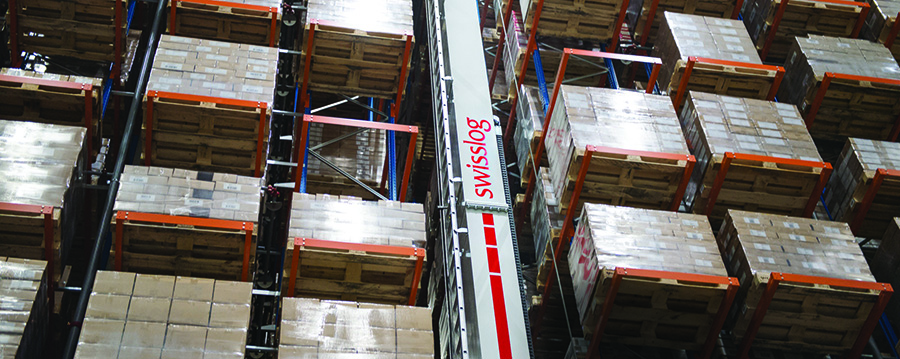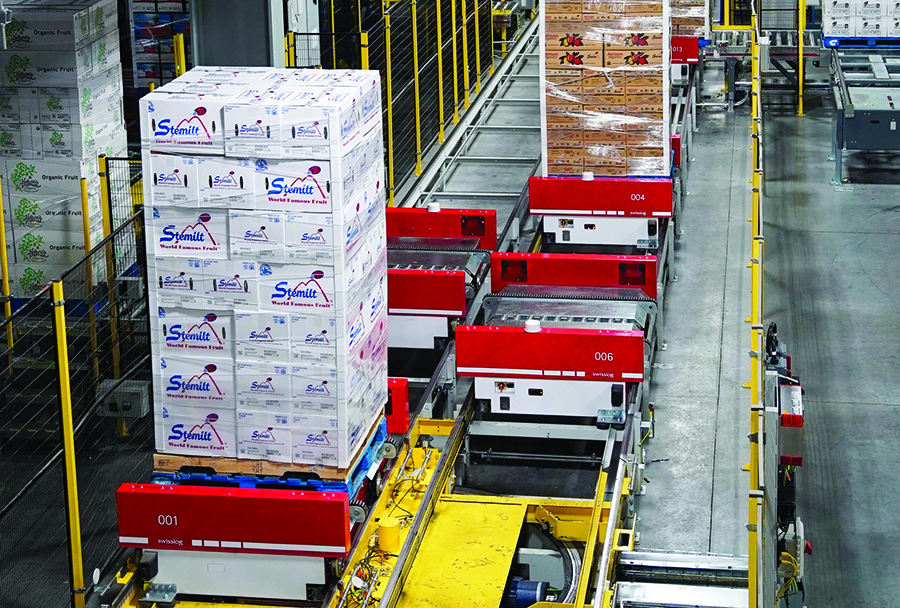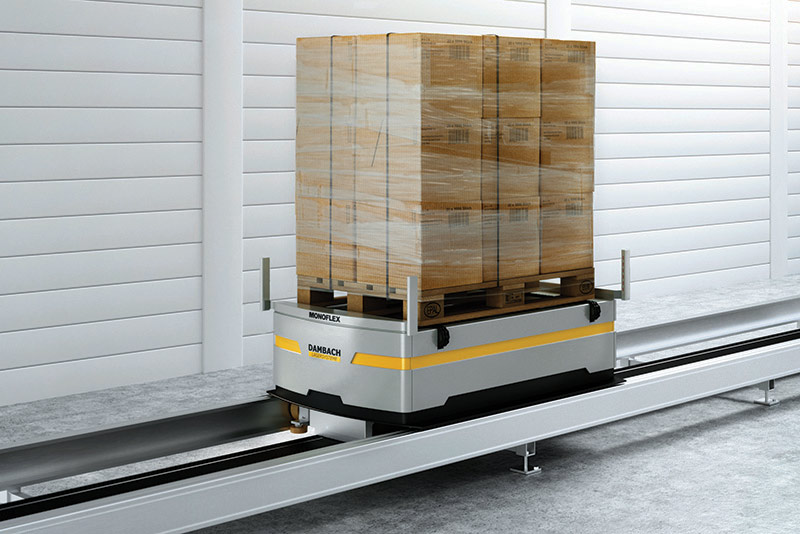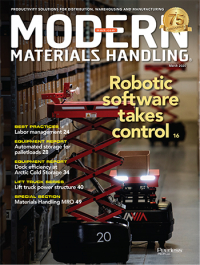High-tech meets low-tech: Automate storage for pallet loads
Here’s how low-tech pallets and high-tech autonomous systems are coming together to streamline the supply chain—both in and out of the warehouse.
With more automation making its way into warehouses and DCs worldwide, the race to streamline fulfillment processes to meet the ever-changing demands of e-commerce and omni-channel is on. As the distribution environment continues to evolve, one workhorse continues to play a critical role in moving goods across the supply chain: the pallet.
Flat transport structures used to move goods with cranes, forklifts and automated storage and retrieval systems (AS/RS), pallets protect shipments, absorb stress, carry weight and absorb impacts from vehicles. And while pallet materials and designs have evolved over time, their basic mission remains intact: help move and store materials quickly, reduce product damage, and minimize the risk of worker injury.
Pallets are also a focal point for manufacturers of warehouse equipment, hardware and software. As the computer-controlled systems that put away, store and retrieve product, AS/RS help to reduce companies’ reliance on human labor and forklifts. When used alongside existing pallet rack systems, for example, fully- and semi-automated pallet shuttle systems help optimize storage space while improving workplace safety.
This marriage of low-tech pallets with high-tech automation is turning out to be a match made in heaven for many companies. “Combining pallets with auto storage creates denser storage and high handling performance, both of which play an increasingly crucial role for third-party logistics companies (3PLs) and warehouse operators,” says Benjamin Thumm, product manager at Dambach Lagersysteme. Key drivers include the diversity of products and customer demands for shorter delivery times. “Higher labor costs and the need to decrease warehouse operating complexity are also playing a role,” he adds.
In most cases, Thumm says the way those pallets and automation are applied depends on the company’s specific cargo, existing storage concept, and/or required output. “The high variance of different pallets within the United States motivates customers searching for new storage and transport solutions,” he explains. “In addition, different storage strategies enable companies to operate single-deep or multiple-deep storage systems.”
Increased adoption of AS/RS
Squeezed by the pressures of e-commerce, omni-channel, labor constraints and higher real estate costs, more companies are infusing automation into their warehouse operations.
At Swisslog, vice president of Logistics Automation Grant Beringer says the company has seen increased adoption of AS/RS over the last few years. He expects the trend to continue due mainly to rising warehouse operating costs. Higher energy costs and rising real estate prices, for instance, are driving the need for smaller and denser storage options.

The labor shortage isn’t making life any easier for warehouse operators. “There are fewer people willing to work in warehouse conditions, which can be physically demanding,” says Beringer. Other factors driving more companies in the AS/RS direction include SKU proliferation, much of which is based on consumer demand. Finally, he says the retail sector is pushing manufacturers to hold more stock to reduce their own inventory holding costs.
“These are the primary factors leading not only to increased adoption of AS/RS, but also different uses of AS/RS technology,” Beringer says. Those alternate uses include equipment that loads/unloads pallets at the dock, replenishes pick faces, delivers pallets to a pick module, or uses shuttles as moles for putaway. Swisslog, for example, has customers in the wine and spirits industry that use AS/RS bulk pallet storage for full-pallet dispatching in their warehouses.
Beringer says AS/RS technology is also being used to replenish pick modules, where associates either pick from a pallet to a conveyor or directly to a store pallet. “We also have applications where AS/RS are used on the shipping dock to stage pallets for upcoming deliveries,” he adds, “and, we’re seeing an increase in the adoption of pallet shuttle technology, with deep-lane storage that can be used to store 20 to 30 pallets per row or location.”
Driven mainly by the need for more flexibility in warehouses and DCs, these pallet-centric uses of AS/RS let companies scale their operations up and down as needed. Take the 3PL that can’t readily predict its SKU profile as it adds new customers to its roster, and that uses pallet shuttles in its facilities. Using that equipment, the 3PL needs to be able to quickly switch things up when its SKU range changes, its business grows, and/or its market shifts. “These companies want flexibility above all else,” Beringer adds.
To address these needs for flexibility, Swisslog now offers “flexible row depth” in its PowerStore pallet shuttle system. Depending on the SKU profile, the depth of the storage location can be configured for each location. “If the SKU profile changes at a later point, the storage depth can be modified without making physical changes to the equipment,” says Beringer, “by simply changing the software configuration.”
Less coordination, fewer stand-alone systems
At Dambach Lagersysteme, Thumm says the company’s Multiflex pallet shuttle system is a scalable storage system already in use across numerous industries. Up next, the manufacturer’s Carrier system will include built-in controls and be pre-commissioned, thus reducing installation times and implementation costs. “The variable system design perfectly suits the demanding U.S. market,” says Thumm, “regardless of load capacity or throughput.”
Keeping up with the latest trends, Dambach has also developed the Monoflex rail guided vehicle (RGV) conveying system for the warehouse’s “front zone.” Similar to a pallet shuttle system, the RGV was built to be both scalable and flexible. It also incorporates inductive power transmission and high-performance capacitors.
“It’s about reducing complexity and costs while increasing performance,” says Thumm, who envisions a time in the not-too-distant future when automated storage becomes even more intelligent and intuitive than it is right now. “As mechanical engineering and controls keep further merging,” he says, “companies will benefit from the need for less coordination and [fewer] stand-alone systems.”

Managing SKU proliferation
As order sizes shift, the way pallets are used in the warehouse changes right along with these trends. Right now, for example, we’re seeing many more mixed pallets moving throughout fulfillment centers—a trend that demands special handling and storage techniques. “SKU numbers are increasing in the retail and food warehousing environment,” says Norman Leonhardt, director of business development at Witron Integrated Logistics. “This creates new challenges and forces companies to use layering or ‘rainbow’ pallets to be able to store a lot of different items.”
Leonhardt also sees more companies using pre-built pallets for crossdocking. For instance, a health and beauty retailer will “prebuild” a pallet that’s sent directly to the store for unloading and placement on the retail floor. That pallet may also be crossdocked at the DC level, effectively streamlining the loading, unloading and sorting process—right down to the single-item level.
To respond to these shifts, Leonhardt says vendors are coming up with new ways to combine automated storage with pallet building, transport and receiving. Some AS/RS, for example, can receive a pallet, record any cases that have been removed from it, and then know exactly what’s left on the pallet. The same system can track the pallet through the fulfillment process, weigh it using scales that are integrated into a conveyor belt, ensure that it’s been built to the right height (i.e., is it too tall or too short?), and ensure good inventory controls.
“When you have constant inventory control, the need for manual inventory counting goes away,” says Leonhardt, who sees Big Data as yet another connecting point between pallets and AS/RS. By connecting pallets to the automated system, warehouse managers can collect data on the former and better understand how many pallets they’ll need on a particular day (then have those ready to use as needed).
More innovation to come
Looking ahead, Leonhardt expects to see more AS/RS used for automated loading and unloading of trucks—an area of warehouse automation that hasn’t quite reached mainstream yet. “That’s something no one has really found a good solution for yet,” he says, “though it might be coming in the next couple of years.”
Looking into his own crystal ball, Beringer says the future of warehouse automation will likely incorporate more use of autonomous systems, machine learning (ML), and Industry 4.0 connected technologies. Specific to AS/RS, this means we’ll see equipment that can monitor the condition of the various components and then use that intelligence for predictive maintenance.
AS/RS for example, will be able to tell the machine operator the exact date and time that its wheels need to be changed.
“The machines will use data and the information contained within their systems to predict and plan ahead; that’s currently in development, if not already in use,” adds Beringer, who sees more innovation ahead for both AS/RS and pallet storage. “AS/RS is not new technology, but it continues to develop in new and exciting ways.”
Companies mentioned in this article:

Article Topics
Equipment Report News & Resources
Radial stays ahead of the automation curve Wireless Mobility: Ready for the next leg up AGVs set new standards for inventory transportation Inside North Shore Care Supply: Bringing robots to receiving Bergen Logistics: Putting robots to work in a multi-tenant facility High-tech meets low-tech: Automate storage for pallet loads Tuggers, carts work together to increase productivity and ergonomics More Equipment ReportLatest in Materials Handling
ASME Foundation wins grant for technical workforce development The (Not So) Secret Weapons: How Key Cabinets and Asset Management Lockers Are Changing Supply Chain Operations MODEX C-Suite Interview with Harold Vanasse: The perfect blend of automation and sustainability Consultant and industry leader John M. Hill passes on at age 86 Registration open for Pack Expo International 2024 Walmart chooses Swisslog AS/RS and software for third milk processing facility NetLogistik partners with Vuzix subsidiary Moviynt to offer mobility solutions for warehouses More Materials HandlingAbout the Author
Subscribe to Materials Handling Magazine

Find out what the world's most innovative companies are doing to improve productivity in their plants and distribution centers.
Start your FREE subscription today.
April 2024 Modern Materials Handling

Latest Resources












